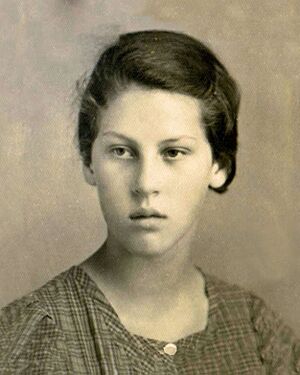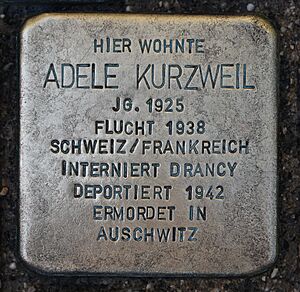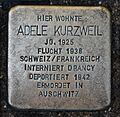Adele Kurzweil facts for kids
Quick facts for kids
Adele Kurzweil
|
|
|---|---|

Photo from Adele's passport (taken in September 1938)
|
|
| Born | 31 January 1925 |
| Died | 9 September 1942 (aged 17) Auschwitz concentration camp, Poland
|
Adele "Dele" Kurzweil (born January 31, 1925 – died September 9, 1942) was a young Austrian girl. She was of Jewish background. The Nazis found her and her family. She was tragically murdered in the Auschwitz concentration camp when she arrived there. Her story became widely known in 1990. This happened after suitcases belonging to her family were found. They were discovered in Auvillar, a town in southern France, where her family had last lived.
Contents
Her Life Story
Growing Up in Graz
Adele Kurzweil was born in Graz, the capital city of Styria, Austria. She was the only child of Bruno Kurzweil and Gisela Trammer. Her father, Bruno, was a lawyer. He worked with the Social Democratic Party, a political group that aimed to help people. Both of her parents were of Jewish descent. In 1926, Adele and her mother left the Jewish community. Her father had done this 14 years earlier.
Adele was named after her grandmother. She grew up safely in a house in the Geidorf area. Pictures from 1928 and 1929 show her playing with other children. They played in her family's garden, which was about a mile from their home. A neighbor's garden was also a favorite spot. Friends of the family called it a "children's paradise."
Adele's friends called her Dele. She went to elementary school near her home. Later, she attended a girls' school (called an Oberlyzeum) in the old part of the city. She went to school there until her family had to leave in 1938. Even though the family faced problems because of the Nuremberg Laws (new rules that made life very hard for Jewish people), her friendship book showed that her teachers and classmates still liked her. Hanna Papanek, a sociologist who met Adele in Paris, described her as "calm and more introverted."
Moving Away and Her Tragic End
Bruno Kurzweil, Adele's father, was a lawyer for the Social Democratic Party. By June 1938, he was banned from working. After Adele finished her school term, her family left Austria. They traveled through Switzerland all the way to Paris, France. Around Christmas 1938, a youth group called "Freundschaft" (which means friendship) started in Paris. It was part of the social-democratic mission there and held weekly meetings.
The next summer, Adele spent a month with 13 other young people. They stayed in a hostel in Le Plessis-Robinson. Hanna Papanek said the group went on trips nearby. They also learned about Marxism, which are ideas about society and economics. When World War II began, Bruno Kurzweil was held for a short time in a camp. Meanwhile, Adele was sent to a children's refugee camp in Montmorency. This camp was run by an organization called Œuvre de secours aux enfants. She went to fourth grade there. Her mother, Gisela, stayed in Paris but wrote letters to Adele. Starting in February 1940, Adele often ended her letters with hopeful words: "Furthermore nothing new with us but a lot in the world. Still, I am convinced that everything will be fine."
The Kurzweil family was reunited. They followed the social-democratic mission to southern France. They settled in Montauban and were registered as refugees from Paris. Adele's father helped many of his friends get exit visas to the United States and Mexico. Adele herself welcomed new refugees at the town's train station.
As the Nazis planned the "Final Solution" (their terrible plan to kill all Jewish people), German authorities searched for Jewish refugees in Vichy France. They eventually found Adele and her parents. On August 26, 1942, Bruno, Gisela, and Adele Kurzweil were arrested in Auvillar. About 120 other people were arrested with them. They were all held in a camp in Septfonds. In early September, the family was moved to Drancy internment camp. Finally, on September 9, they were deported to Auschwitz concentration camp. They were murdered upon arrival.
Adele Kurzweil's Suitcase
In 1990, a history student found several suitcases and other items. These included furniture and a large trunk. They were found at the Auvillar police station. The suitcases held passports and important papers. They also contained everyday things like toothbrushes and towels. After the war, these items had been stored in a city office for many years.
Local historians Pascal Caila and Jacques Latu used the documents they found. They were able to piece together the Kurzweil family's story. All the documents were given to the Musée de la résistance et de la deportation (museum of resistance and deportation) in Montauban. This is where the family had lived between 1940 and 1942.
In 1994, a history teacher in Montauban started a project. Her students focused on the Holocaust and the persecution of minorities. They created an exhibition about Adele Kurzweil. Eventually, the schoolyard was named after Adele. The students received an award from the Sorbonne for their work.
Later, these students worked with students in Graz, Adele's hometown. This led to another project there. They researched archives and talked with people who survived the Holocaust. The result was an exhibition in the Graz synagogue. It opened in November 2001 and became very popular. It was shown in several places across Austria.
A teacher named Peter Gstettner called the suitcases a "cultural relict." He said they offer a look into the personal side of escaping danger. They are a valuable part of our collective memory. The items in Kurzweil's suitcase show how difficult and violent the experience of being a refugee and being deported was. Gstettner believes that items like these help us learn about the terrible crimes of Nazism in a personal and emotional way.
Images for kids








